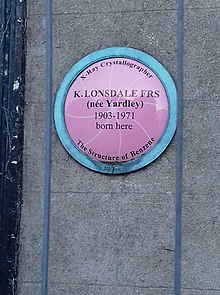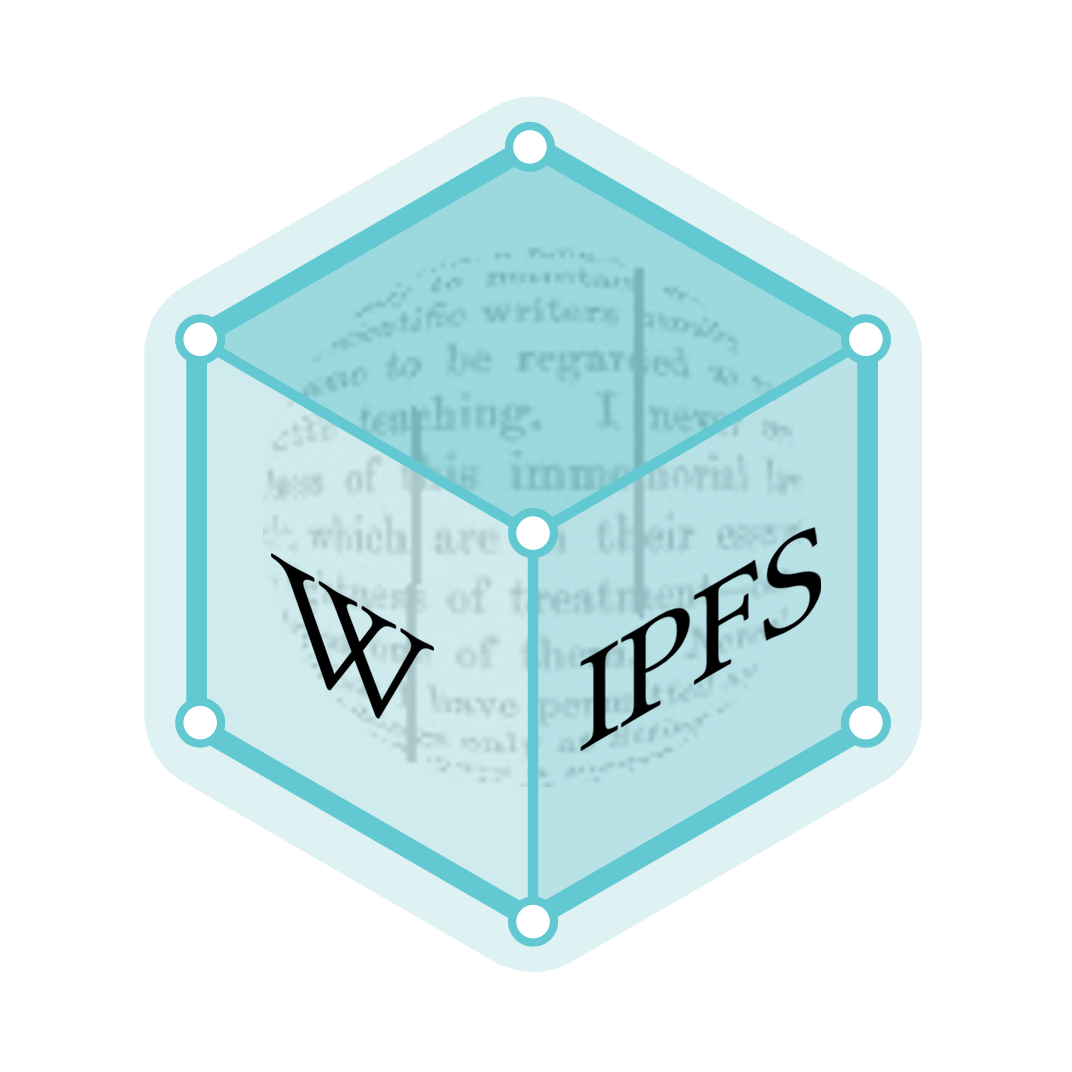Kathleen Lonsdale
Dame Kathleen Lonsdale DBE FRS (née Yardley; 28 January 1903 – 1 April 1971) was an Irish pacifist, prison reformer and crystallographer. She proved, in 1929, that the benzene ring is flat by using X-ray diffraction methods to elucidate the structure of hexamethylbenzene.[1] She was the first to use Fourier spectral methods while solving the structure of hexachlorobenzene in 1931. During her career she attained several firsts for female scientists, including being one of the first two women elected a Fellow of the Royal Society (FRS) in 1945[4] (along with Marjory Stephenson), first woman tenured professor at University College London, first woman president of the International Union of Crystallography, and first woman president of the British Association for the Advancement of Science.[5][6][7][8][9][10][11]
Dame Kathleen Lonsdale DBE FRS | |
|---|---|
.jpg.webp) Lonsdale in 1968 | |
| Born | Kathleen Yardley 28 January 1903 Newbridge, County Kildare, Ireland |
| Died | 1 April 1971 (aged 68) London, England |
| Alma mater | Bedford College for Women University College London |
| Known for | X-ray crystallography[1][2][3] |
| Awards | Davy Medal (1957) Fellow of the Royal Society[4] |
| Scientific career | |
| Fields | Crystallographer |
| Institutions | University College London Royal Institution University of Leeds |
| Doctoral advisor | William Henry Bragg |
Early life and education
She was born Kathleen Yardley at Newbridge, County Kildare, Ireland, the tenth child of Harry Yardley, the town postmaster, and Jessie Cameron. Her family moved to Seven Kings, Essex, England, when she was five years old.[5] She studied at Woodford County High School for Girls, then transferred to Ilford County High School for Boys to study mathematics and science, because the girls' school did not offer these subjects. She earned her Bachelor of Science degree from Bedford College for Women in 1922, graduating in physics with an MSc from University College London in 1924.[12]
Career and research
In 1924 she joined the crystallography research team headed by William Henry Bragg at the Royal Institution. From 1929 to 1934, she started a family and largely stayed at home while continuing her work calculating structure factors.[13][14]
In 1934, Lonsdale returned to work with Bragg at the Royal Institution as a researcher. She was awarded a DSc from University College London in 1936 while at the Royal Institution. In addition to discovering the structure of benzene and hexachlorobenzene, Lonsdale worked on the synthesis of diamonds. She was a pioneer in the use of X-rays to study crystals. Lonsdale was one of the first two women elected a Fellow of the Royal Society (FRS) in 1945[4] (the other was the biochemist Marjory Stephenson).
In 1949 Lonsdale was appointed professor of chemistry and head of the Department of Crystallography at University College London.[5] She was the first tenured woman professor at that college, a position she held until 1968 when she was named Professor Emeritus.
Selected publications
| Library resources about Kathleen Lonsdale |
| By Kathleen Lonsdale |
|---|
- Simplified Structure Factor and Electron Density Formulae for the 230 Space Groups of Mathematical Crystallography, G. Bell & Sons, London, 1936.
- "Divergent Beam X-ray Photography of Crystals," Philosophical Transactions of the Royal Society 240A: 219 (1947).
- Crystals and X-Rays, G. Bell & Sons, London, 1948.
- Quakers visit Russia, Edited by Kathleen Lonsdale : an account of a visit to the Soviet Union in July 1951 by seven British Quakers, 145 pages. Published by the East-West Relations Group of the Friends Peace Committee. Other authors: Margaret Ann Backhouse,[15] B Leslie Metcalfe, Gerald Bailey, Paul S Cadbury, Mildred Creak, Frank Edmead.
- Removing the Causes of War, 1953.
- Is peace possible? (1957)
- Forth in Thy Name: The Life and Work of Godfrey Mowatt (1959)[16]
Legacy and honours

- She was elected an Honorary Member of the Women's Engineering Society in 1946 in recognition of her "brilliant and important work".[17]
- 1956, she was made Dame Commander of the Order of the British Empire.[18]
- 1966, she was elected as the first woman president of the International Union of Crystallography.[18]
- 1967, active in encouraging young people to study science, she was elected as the first woman president of the British Association for the Advancement of Science.[5]
- There are buildings named in her honour at University College London, at the University of Limerick,[19] and at Dublin City University.[20]
- 1969, she was awarded an Honorary Degree (Doctor of Science) by the University of Bath.[21]
- Lonsdaleite, an allotrope of carbon, was named in her honour; it is a rare harder form of diamond found in meteorites.[22][23]
- A plaque was erected on Lonsdale's family home in Newbridge by the National Committee for Commemorative Plaques in Science and Technology in 2003, 100 years after her birth.[24]
Personal life

After beginning her research career, in 1927 Yardley married Thomas Jackson Lonsdale. They had three children – Jane, Nancy, and Stephen. Stephen became a medical doctor and worked for several years in Nyasaland (now Malawi).
Pacifism
Though she had been brought up in the Baptist denomination as a child, Kathleen Lonsdale became a Quaker in 1935, simultaneously with her husband. Already committed pacifists, both were attracted to Quakerism for this reason.[25] She was a Sponsor of the Peace Pledge Union.
.jpg.webp)
She served a month in Holloway prison during the Second World War because she refused to register for civil defence duties, or to pay a fine for refusing to register. During this time she experienced a range of issues which would eventually result in Lonsdale becoming a prison reform activist[26] and she joined the Howard League for Penal Reform.[27]
"What I was not prepared for was the general insanity of an administrative system in which lip service is paid to the idea of segregation and the ideal of reform, when in practice the opportunities for contamination and infection are innumerable, and those responsible for re-education practically nil"[28]
In 1953, at the annual meeting of the British Quakers, she delivered the keynote Swarthmore Lecture, under the title Removing the Causes of War. A self-identified Christian pacifist,[29] she wrote about peaceful dialogue and was appointed the first secretary of Churches' Council of Healing by the Archbishop of Canterbury William Temple.[30]
Death
Lonsdale died on 1 April 1971, aged 68, from an anaplastic cancer of unknown origin.
References
- Lonsdale, K. (1929). "The Structure of the Benzene Ring in C6 (CH3)6". Proceedings of the Royal Society A: Mathematical, Physical and Engineering Sciences. 123 (792): 494–515. Bibcode:1929RSPSA.123..494L. doi:10.1098/rspa.1929.0081.
- Lonsdale, K. (1931). "An X-Ray Analysis of the Structure of Hexachlorobenzene, Using the Fourier Method". Proceedings of the Royal Society A: Mathematical, Physical and Engineering Sciences. 133 (822): 536. Bibcode:1931RSPSA.133..536L. doi:10.1098/rspa.1931.0166.
- Lonsdale, K. (1944). "Diamonds, Natural and Artificial". Nature. 153 (3892): 669. Bibcode:1944Natur.153..669L. doi:10.1038/153669a0.
- Hodgkin, D.M.C. (1975). "Kathleen Lonsdale (28 January 1903 – 1 April 1971)". Biographical Memoirs of Fellows of the Royal Society. 21: 447–26. doi:10.1098/rsbm.1975.0014.
- Hudson, G. (2004). "Lonsdale, Dame Kathleen (1903–1971)". Oxford Dictionary of National Biography (online ed.). Oxford University Press. doi:10.1093/ref:odnb/31376. (Subscription or UK public library membership required.)
- Staff (2004). "Kathleen Lonsdale profile". Encyclopedia of World Biography. Retrieved 20 October 2012. Or see alternative source.
- Staff (January 2003). "Chemistry World: Woman of substance". Royal Society of Chemistry. Retrieved 20 October 2012.
- Staff. "Kathleen Yardley Lonsdale 1903–1971". CWP at University of California. Archived from the original on 5 October 2016. Retrieved 20 October 2012.
- Staff. "Papers and correspondence of Dame Kathleen Lonsdale, 1903–1971". ArchivesHub.ac.uk. Retrieved 20 October 2012. An overview of the scope and content of the collection of Lonsdale's papers that are kept at University College London.
- Reville, William (2004). "Kathleen Lonsdale – Famous Irish Scientist" (PDF). University College Cork. Retrieved 20 October 2012. This article first appeared in The Irish Times, 13 December 2001.
- "Archival material relating to Kathleen Lonsdale". UK National Archives.

- Authier, André (1 August 2013). Early Days of X-ray Crystallography. OUP Oxford. ISBN 9780191635014.
- January 2003, Chemistry World1. "Woman of substance". Chemistry World. Retrieved 19 December 2018.
- Baldwin, Melinda (20 March 2009). "'Where are your intelligent mothers to come from?': marriage and family in the scientific career of Dame Kathleen Lonsdale FRS (1903–71)". Notes and Records. 63 (1): 81–94. doi:10.1098/rsnr.2008.0026. ISSN 0035-9149. PMID 19579358.
- "Margaret Ann Backhouse". Oxford Dictionary of National Biography (online ed.). Oxford University Press. 2004. doi:10.1093/ref:odnb/103381. ISBN 9780198614111. (Subscription or UK public library membership required.)
- Lonsdale, Dame Kathleen (1959). Forth in Thy Name: The Life and Work of Godfrey Mowatt. Wykeham Press. Retrieved 24 December 2015.
- "The Woman Engineer". www2.theiet.org. Retrieved 24 May 2019.
- "Most influential British women in science". royalsociety.org. Retrieved 1 December 2016.
- "Dictionary of Irish Biography – Cambridge University Press". dib.cambridge.org. Retrieved 1 December 2016.
- DCU names three buildings after inspiring women scientists Raidió Teilifís Éireann, 5 July 2017
- "Honorary Graduates 1966 to 1988 | University of Bath". Bath.ac.uk. Retrieved 31 October 2012.
- Frondel, C.; U.B. Marvin (1967). "Lonsdaleite, a new hexagonal polymorph of diamond". Nature. 214 (5088): 587–589. Bibcode:1967Natur.214..587F. doi:10.1038/214587a0. S2CID 4184812.
- Frondel, C.; U.B. Marvin (1967). "Lonsdaleite, a hexagonal polymorph of diamond". American Mineralogist. 52 (5088): 587. Bibcode:1967Natur.214..587F. doi:10.1038/214587a0. S2CID 4184812.
- Mulvihill, Mary (27 January 2003). "An Irishwoman's Diary". The Irish Times. Retrieved 10 December 2020.
- "Quakers in the World – Kathleen Lonsdale". quakersintheworld.org. Retrieved 1 December 2016.
- Lonsdale, Dame Kathleen; Page, Roger (1943). Some Account of Life in Holloway Prison for Women. Prison Medical Reform Council.
- Logan, A. (3 November 2008). Feminism and Criminal Justice: A Historical Perspective. Springer. ISBN 9780230584136.
- Brock, Peter (2004). "These Strange Criminals": An Anthology of Prison Memoirs by Conscientious Objectors from the Great War to the Cold War. University of Toronto Press. ISBN 9780802086617.
- Lonsdale, Kathleen Yardley. 1957. Is peace possible?. Penguin Books. p. 95
- Harpur, Tom. 2013. The Uncommon Touch. McClelland & Stewart. p. 76
External links
- Science in the Making Kathleen Lonsdale's papers in the Royal Society's archives
